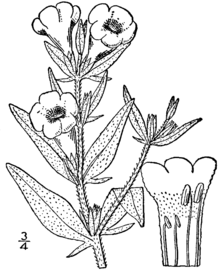Agalinis auriculata
| Agalinis auriculata | |
|---|---|
 | |
| Scientific classification | |
| Kingdom: | Plantae |
| (unranked): | Angiosperms |
| (unranked): | Eudicots |
| (unranked): | Asterids |
| Order: | Lamiales |
| Family: | Orobanchaceae |
| Genus: | Agalinis |
| Species: | A. auriculata |
| Binomial name | |
| Agalinis auriculata (Michx.) S.F.Blake | |
Agalinis auriculata is a species of flowering plant in the broomrape family known by the common names earleaf false foxglove, auriculate false foxglove, and earleaf gerardia. It is native to the United States, where it occurs from Minnesota to New Jersey to the southern states.[1]
This plant is a hairy annual herb producing a stiff stem up to 90 centimeters tall. The flowers are pink with purple spots and they bloom in July through September.[2] The plant is hemiparasitic, green with chlorophyll to accomplish photosynthesis, but also parasitic on other plants to obtain some nutrients. In cultivation the plant was able to parasitize Helianthus occidentalis and Rudbeckia fulgida and it was observed to connect to a grass, possibly Poa compressa, in the field.[1]
This plant has a widespread distribution and it was formerly more common than it is today. It appears to require soil disturbance in order to germinate. In the past, this disturbance may possibly have been caused by herds of bison. The plant can colonize mounds of earth which has been turned over by pocket gopher (Geomys bursarius).[1]
There are 40 to 50 known occurrences today, mostly made up of small populations. The largest populations are in Arkansas, Missouri, and Mississippi.[1]
References
- 1 2 3 4 Agalinis auriculata. Archived October 26, 2011, at the Wayback Machine. Center for Plant Conservation.
- ↑ Agalinis auriculata. The Nature Conservancy.
